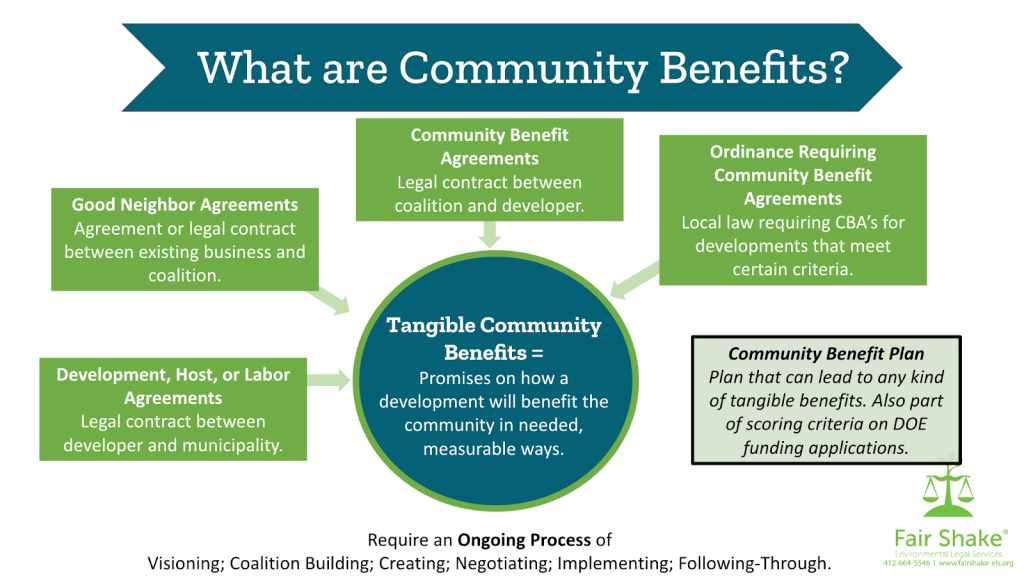Disclaimer: This information was accurate as of December 2024 and may no longer be current.
December 11, 2023
Special thanks for this information compiled by our friends at Fair Shake Environmental Legal Services, a 501(c)(3) nonprofit law firm that believes all people and communities should have access to the tools of change, and that everyone has the right to make decisions about the air, water, and land where they live, work, and play.
They are always available to chat with folks interested in learn more about Community Benefits.
Please contact: Meagan Niebler at [email protected] directly for more information.

You may have heard of Community Benefits Plans (CBPs), but what are they really?
A Community Benefits Plan is a voluntary guideline outlining how a developer plans to collaborate with communities throughout their privately-funded projects. A CBP can help set the stage for future legal agreements and rules around the benefits communities receive from this project.
But is a Community Benefits Plan different from a Community Benefits Agreement (CBA)? In short, yes!; a CBA is one possible outcome of community engagement that is part of a Community Benefits Plan. So while they have similar names, the two are different!


There are many paths, or levers, that lead to community benefits. This is, in part, because “community benefits” is an umbrella term including a variety of ways in which developments provide tangible, measurable, and community-driven benefits within a community. Some levers include:
- Host or Development Agreements:
these are a legal contract between a new developer and a municipality showing that the developer will accept certain guidelines in exchange for municipality support for the development. - Good Neighbor Agreements:
these are legal private contracts between an existing business and a community coalition in which the business agrees to change its behavior to support the community - Community Benefit Agreements:
these are legal, private contracts between a new developer and a community coalition in which the developer agrees to provide specific benefits to the community in exchange for the community coalition’s support of the development project - Ordinance requiring Community Benefit Agreements:
this is when the municipality passes a local law requiring Community Benefit Agreements (CBAs) or that a community benefits from the developments that meet a certain criteria defined in the law - Community Benefit Plan:
different from a Community Benefit Agreement (CBA), a Community Benefit Plan (CBP) is a specific term required by any project applying for Infrastructure Law and Inflation Reduction Act funding opportunities through the Department of Energy. The CBP must include details about how the development will meet the DOE’s four core policy priorities:- Investing in the workforce
- Engaging communities and labor
- Advancing diversity, equity, inclusion, and accessibility
- Implementing Justice40
While these levers portray various processes, it is important to remember that community benefits are an ongoing process of visioning, relationships, negotiation, and follow-through. Strong development agreements can require CBAs. An example of this could be that new housing development that is within a certain health overlay zone could include 30% affordable housing units and in exchange, the municipality would provide a tax break and waive permit fees.


source: https://goodjobsfirst.org/wp-content/uploads/docs/pdf/cba2005final.pdf
Our partners at RMI have further explained the difference between Community Benefit Agreements (CBAs) and Community Benefits Plans (CBPs):

Community Benefits Agreements:
- Legally binding agreements negotiated between community organizations and developers
- Outline specific benefits that the developer will provide to the community in exchange for the community’s support of the project
- Enforceable in court, which gives communities a stronger guarantee that the developer will follow through on its commitments
- Not required as part of a CBP or for a DOE application, a CBA can be an outcome of a CBP

Community Benefits Plans:
- Non-legally enforceable agreements by a project developer, in consultation with the affected community
- Outline a developer’s commitment to the community’s needs (e.g. affordable housing, job creation, etc.)
- Required as part of DOE funding applications
- Evaluated as part of the application scoring or when assessing the loan’s repayment prospect
Instead of having separate groups only going to the city or redevelopment agency for community benefits, a coalition is necessary to fight for a unified vision with the city and the developer. Our partners at Fair Shake Environmental Legal Services have compared the community outcomes of development with and without a Community Benefit Process:

Without a Community Benefit Process:
- In general, developers seek government subsidies, and they need permits and other forms of government approval.
- Little or no communication between community and developer.
- All development promises go to the municipality or are handshakes or marketing/PR.
- Little coordination between community groups.
- No enforcement mechanism for the community.

With a Community Benefit Process:
- Developer commitments go into CBA.
- Coalition and developer draft benefits together.
- Community can enforce commitments.
- Community members build a coalition to share information, have strength in numbers, and coordinate advocacy.
- Government entities can approve projects without strong opposition from coalitions.
- CBA processes have the chance to shift the power back into the community.
